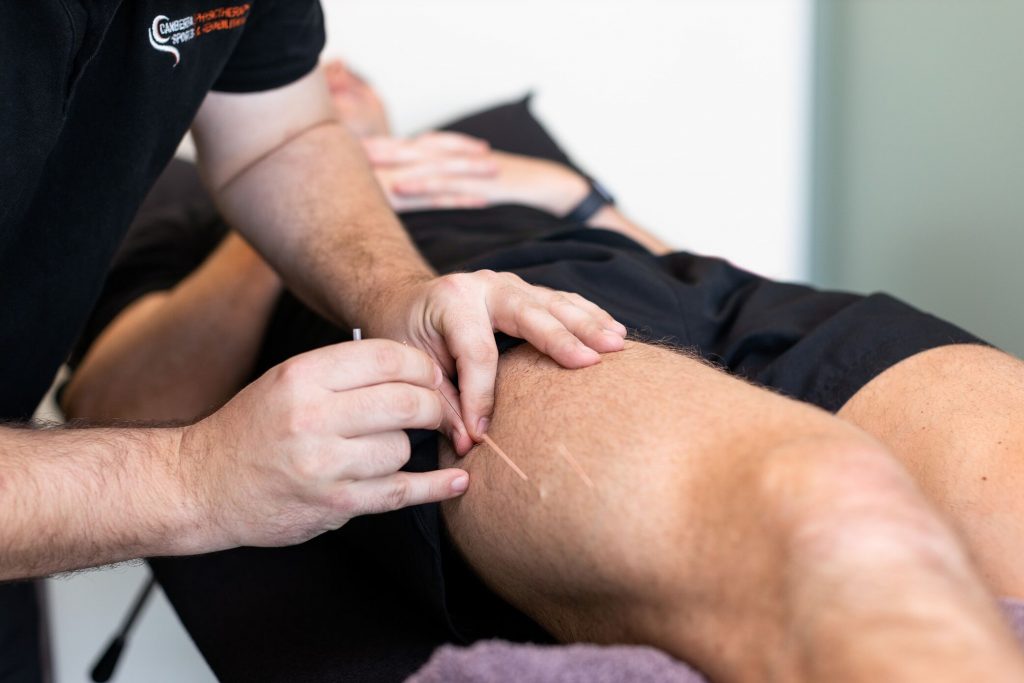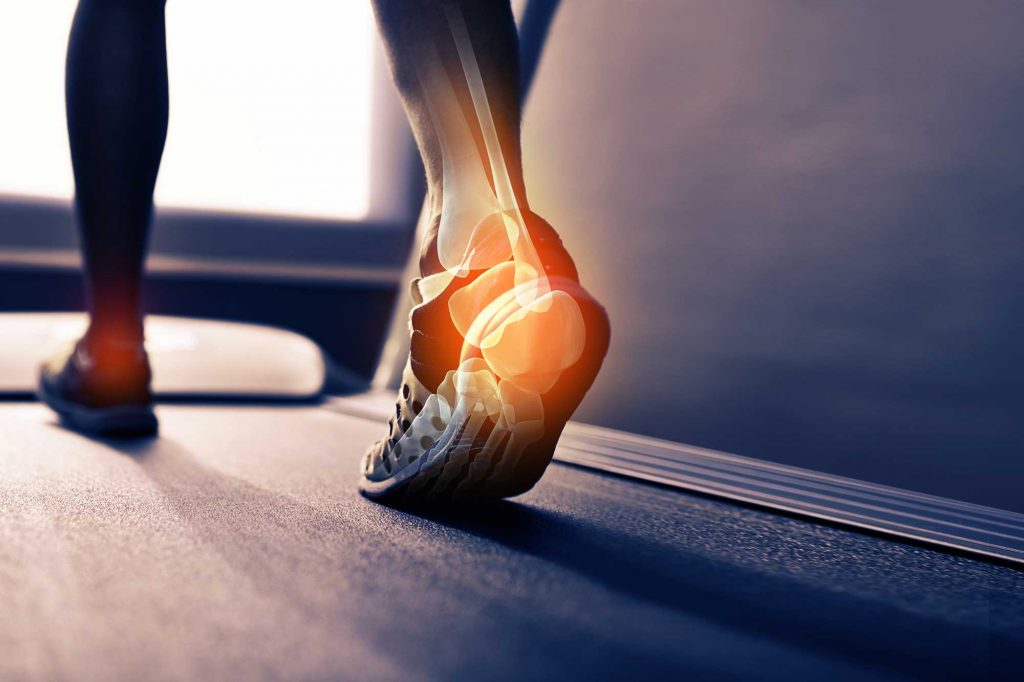Athletes, or anyone participating in a sporting activity, are prone to injuries due to the very nature of that activity. Injuries involving the ankle are quite common, especially in sports like basketball where the ankle receives a great deal of twisting stress. Sports injuries of the foot are just as common but are not as well known. This article will discuss some of the more common sports injuries affecting the foot itself, and how they are typically treated. It should be stressed beforehand that all foot injuries should be medically assessed by a foot specialist due to the complex nature of the foot’s structure and function, as minor issues ignored can often lead to complex future foot problems.

There are several common parts of the foot that become injured in sports, each with its own cause and treatment. What follows is a description of each condition, its cause, and how it is typically treated.
Plantar Fasciitis: One of the most common foot injures in athletes and sedentary people alike, plantar fasciitis involves inflammation and microscopic tearing of a broad band of tissue (plantar fascia). This tissue runs from the heel bone to the ball of the foot. It is seen primarily in people with flat feet as well as those with high arches. Flat feet cause chronic stretching of the fascia, while high arches allow for poor shock absorption leading to fascia injury. Stepping on hard, blunt objects like a rock or over-stretching the foot on a stair or ladder rung can directly injure the fascia, although these injury patterns are less common. The fascia can also rupture if the force of the injury is severe enough. Plantar fascial ruptures are far more common in sports injuries than during any other typical situation in which the plantar fascia becomes injured. The pain of typical plantar fasciitis is usually felt on the inner side of the bottom of the heel where it meets the arch and is noticed after arising from a chair or bed, as well as after extended activity. This condition can persist for years if untreated, leading to a chronic state of scar tissue and thickening. Treatment is simple, and involves stretching, inflammation reduction with icing, medication, and cortisone-like injections, as well as orthotics (specialized shoe inserts) to provide flat feet greater support and high arches more shock absorption. Only in a few cases is surgery needed, although newer techniques and technologies have made this procedure easier to recover from.

Peroneal Tendonitis: The peroneal tendons are two tendons (one short, one long) that run behind the outside of the ankle from the leg and insert on the side of the foot and underneath the arch, respectively. These tendons help to roll the foot up and out and are important to the walking cycle. When a strong force rolls the foot inward, or when activity on uneven surfaces (like gravel or a field with divots) goes on for a while, one or both of these tendons can become inflamed, fray, or partially torn. Peroneal tendon partial split tears are quite common, although one can have a partial tear and not even feel it due to the flat nature of the tendon. The degenerative process affecting the peroneal tendons can take a while to develop but can be fairly disabling when it becomes severe. Treatment involves icing, anti-inflammatory medications, therapy, and bracing to allow the tissue to heal and become strong again. Tendons that will not heal will need surgical intervention. Surgical intervention involves repairing any tear found, healing the tendon with a newly developed radio frequency wave device, and augmenting any weak or frayed area with a special tissue graft that essentially turns into the tendon material it covers. In severe cases the tendon may need to be transferred to give it better functional capability.
Sesamoiditis: The sesamoids are two small egg-shaped bones found under the big toe joint, just behind where the toe meets the foot. Chronic, stressful activities such as high impact jumping, or hard surface running can lead to inflammation and bruising of one or both bones. This bruising slowly develops over time, and continued stress will multiply the tissue damage. Eventually this damage may lead to stress cracks of the bone. Immediate injuries can even occur, causing outright fracturing of the bone if the injury force is severe enough, and this can also be seen with long term stress damage if the bone is weakened without relief. The pain of this condition is felt just underneath the big toe joint, usually in a very specific location. Pressure on the inside ball of the foot becomes painful and running or jumping will become difficult. Unless a fracture has occurred, swelling and bruising are usually not seen. Treatment centres on reducing the inflammation by reducing the stress to this site. This can be accomplished using special pads or prescription inserts which direct pressure away from the sesamoids. The usual injury treatment regimen of icing, rest, and anti-inflammatory medications is also used. Sesamoiditis cases can be injected with steroid medication, while a stress fracture or full fracture should be treated otherwise. More serious injuries may need to be immobilized in a walking boot for a few weeks to months depending on the severity, and fractured sesamoids that will not heal may need to be removed surgically.

Stress Fractures: Any bone in the foot can be at risk for developing a stress fracture. Unlike a regular fracture, a stress fracture does not involve a true break across the bone, but rather an injury to the structure within the bone. Repetitive activities, such as running consistently on a hard surface, can lead to bone bruising, and then ultimately to a partial break in the honeycomb structure of the inner bone. Other factors include tight muscles that lead to abnormal foot functioning during intensive exercise, stiff, high arched feet, bone density or menstruation issues in women, and anatomic abnormalities. These injures are usually not seen on standard x-rays until after several months. The most common sports-related location of stress fractures in the foot are the long metatarsal bones and the heel bone. When the injury is untreated and at-fault activity is continued, these stress fractures have the potential to turn into full fractures. Treatment involves rest, immobilization in a walking boot or cast, and time to mend. Stress fractures are notorious for taking longer to heal than a fresh fracture, and patience is often needed during the healing process to achieve full recovery. Electronic bone stimulators can be used for cases that have stalled healing, although insurance coverage of these expensive devices varies.
Turf Toe: Turf toe is an injury so-called because the pattern of injury usually involves the big toe striking the ground (turf) during a kicking motion, such as seen in soccer. The big toe joint has strong tissues surrounding it to keep the joint in place. Collectively known as a capsule, these tissues are essentially the combined ligaments that bind the two bones together that form the joint. When an injury occurs that forces the toe up, down, or off to one side, more than the strength of this capsule, a strain or partial tear will occur. Although the original turf toe described the toe flexing downward into the ground, it can be used to describe excess motion in any direction. In this condition, although the big toe will not dislocate as the tearing of the ligaments is only partial, it will become inflamed and quite tender to move. Since all walking and running requires the big toe joint to move upwards frequently, sports activity becomes quite difficult. Treatment involves simply allowing the tissues to heal by icing the inflammation, taking oral anti-inflammatory medications, taping the toe, using a hard-soled shoe, and resting from activity until a slow gradual return to sports is tolerated.
While all the above conditions are easily treated, many athletes often delay obtaining proper treatment out of a fear of having to discontinue their activity. Treatment delay not only allow the injury to worsen, but it also can lead to a more complicated injury pattern that is far more difficult to properly heal from. Sports injuries of the foot, even seemingly minor ones, should have a proper evaluation by a foot specialist due to the unique nature of the foot in relation to our body and the requirements of walking.
Manningham Foot Clinic is the ideal place to get the right treatment for any of your foot injuries and other treatments. They are located in Craigieburn, VIC.




Thanks for sharing the full medical importance of sports injuries. Health skin beauties is a blog where you can find lots of solution of health, skin, beauty, makeup lifestyle, and many more. We are sharing our knowledge in this blog dedicatedly. I Hope, you connected with us.